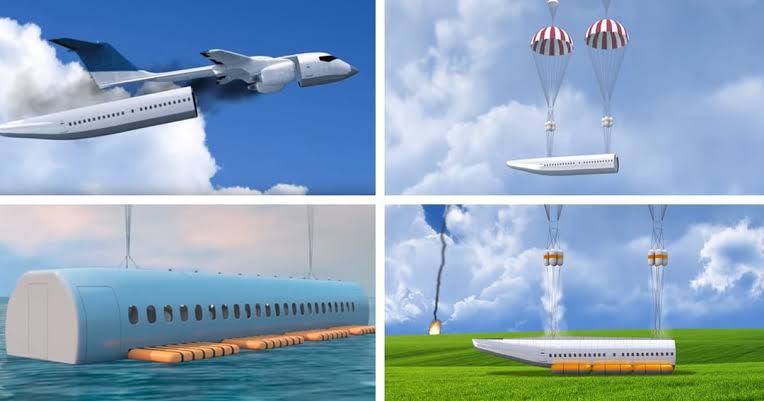The concept of a detachable plane cabin is a cutting-edge aviation technology aimed at improving safety, efficiency, and passenger experience in the event of an emergency or emergency landing.

Key Features of Detachable Plane Cabin Technology:
- Emergency Escape: In the event of a malfunction, crash, or emergency landing, the detachable cabin would separate from the aircraft. This could help reduce fatalities by allowing the cabin to land separately with minimal damage and protecting passengers.
- Autonomous Control: In some designs, the detachable cabin could be equipped with its own propulsion and guidance system, allowing it to navigate to a safe area or land safely after detaching from the plane.
- Modular Design: The detachable cabin would likely be designed to be modular, so it can be easily attached or detached, and optimized for specific aircraft models. It might have inflatable flotation devices, parachutes, or other mechanisms to help it stay afloat or safely descend.
- Safety Mechanisms: Advanced safety features such as airbags, shock absorbers, and life support systems could be integrated to help protect passengers during the descent and impact.
- Cost and Practical Challenges: One of the main challenges of such technology is the added weight, complexity, and cost of the system. Additionally, creating a cabin that can withstand the extreme conditions of air travel and separation from the main body of the plane is a significant engineering hurdle.
While the detachable cabin concept is not yet in use in commercial aviation, various companies, including those in Russia, have explored ideas around improving aircraft safety. Some researchers and aviation engineers have proposed concepts for more “safe-flight” technologies, including capsules or cabins that could detach during emergencies. However, the practical implementation of such technology is still in the early stages, and there are no widely known, operational systems yet.

The technology behind a detachable plane cabin combines several advanced engineering concepts and innovations aimed at ensuring passenger safety and improving response mechanisms in emergency scenarios. The main technologies that would be used for a detachable plane cabin involve:
1. Separation Mechanism
- Explosive Bolts or Mechanical Latches: A high-strength separation mechanism is essential for safely detaching the cabin. Explosive bolts or hydraulic/mechanical latches would be used to release the cabin from the main fuselage. These bolts would be engineered to be triggered in an emergency scenario, ensuring that the separation occurs in a controlled and safe manner.
- Automated Activation: The separation process could be automated, relying on sensors or on-board flight systems to determine when a detachment is necessary, for example, during loss of structural integrity or in the case of a catastrophic event.
2. Autonomous Guidance and Propulsion Systems
- Onboard Propulsion: After detaching, the cabin would need its own propulsion system to steer and control its descent. This could include:
- Jet Engines or Rocket Propulsion: A small-scale jet engine or rocket system could be integrated into the detachable cabin, providing propulsion for safe maneuvering after detachment.
- Parachute or Glider System: In the absence of propulsion, a parachute system (either large single or multiple smaller ones) could be deployed to control the speed and direction of the descent. Glider-like wings might also assist with a controlled landing.
- Autonomous Flight Control: Advanced autopilot technology could help guide the detachable cabin toward safe zones or designated landing areas. This would likely involve AI-driven systems that monitor real-time data from the aircraft, adjusting the cabin’s trajectory accordingly.
3. Structural Integrity and Crash Safety
- Shock Absorption: To minimize impact forces, the detachable cabin would be designed with advanced shock-absorbing materials such as airbags, inflatable systems, or crumple zones. These would help reduce the impact on passengers during the descent.
- Lightweight Materials: Materials such as carbon fiber, titanium, or advanced composites would be used to reduce the overall weight of the cabin while maintaining structural integrity. These materials would also improve the overall strength and safety of the cabin during detachment and impact.
4. Life Support Systems
- Oxygen Supply: The cabin would have built-in oxygen masks and air systems to ensure passengers can breathe if the main aircraft loses cabin pressure. It would include portable oxygen systems or reserves that automatically deploy when needed.
- Survival Kits: Detachable cabins could be equipped with survival kits containing food, water, and medical supplies for emergency situations.
- Fire-Resistant Materials: Given that the cabin could potentially be exposed to intense heat or flames, it would be constructed from materials that are highly resistant to fire.
5. Communication Systems
- Automatic Positioning and Communication Systems: The cabin would be equipped with systems to maintain communication with air traffic control or rescue teams. This could include GPS tracking, radio communication, or satellite links that relay the cabin’s location and status in real-time, ensuring a prompt rescue operation.
- Flight Data Recording: The detachable cabin might also carry a black box or flight data recorder to help understand what occurred during the emergency, aiding investigations and improving future safety measures.
6. Passenger Egress and Safety
- Ejection Seats or Secure Harnesses: In some designs, the cabin could feature ejection seats or secure harness systems that keep passengers in place while ensuring that they remain protected during detachment and descent.
- Escape Routes: In an emergency, the cabin could have several escape routes or mechanisms (such as rapid deployment doors) that allow passengers to exit immediately upon landing.
Challenges and Considerations:
- Weight and Aerodynamics: One of the biggest challenges is ensuring the detachable cabin does not significantly affect the weight or aerodynamics of the main aircraft. Aircraft are designed with strict limitations on weight, and adding a whole separate, detachable structure can be difficult.
- Cost and Certification: Implementing this kind of technology would add significant cost to aircraft manufacturing, and the system would need to undergo rigorous testing and certification by aviation authorities to ensure its safety and effectiveness.
- Reliability: The system would need to be extremely reliable. A failure in the separation mechanism, propulsion, or descent could lead to disastrous outcomes.
Current Status and Use:
As of now, the detachable cabin concept is more of an idea in the concept and experimental phases rather than a widely implemented technology. Various engineers and researchers around the world have explored this idea in the context of aviation safety, and several prototypes or conceptual designs have been suggested by aviation companies, including research in Russia.
However, mainstream aviation has not yet adopted this concept on commercial aircraft, likely due to technical, financial, and regulatory challenges. Some related technologies, such as emergency escape capsules, are being developed for spacecraft, and there may be some inspiration drawn from these fields for aircraft designs in the future.


Leave a Reply